After Promising Net Zero Commitments, How to Expedite Geothermal Advancement?
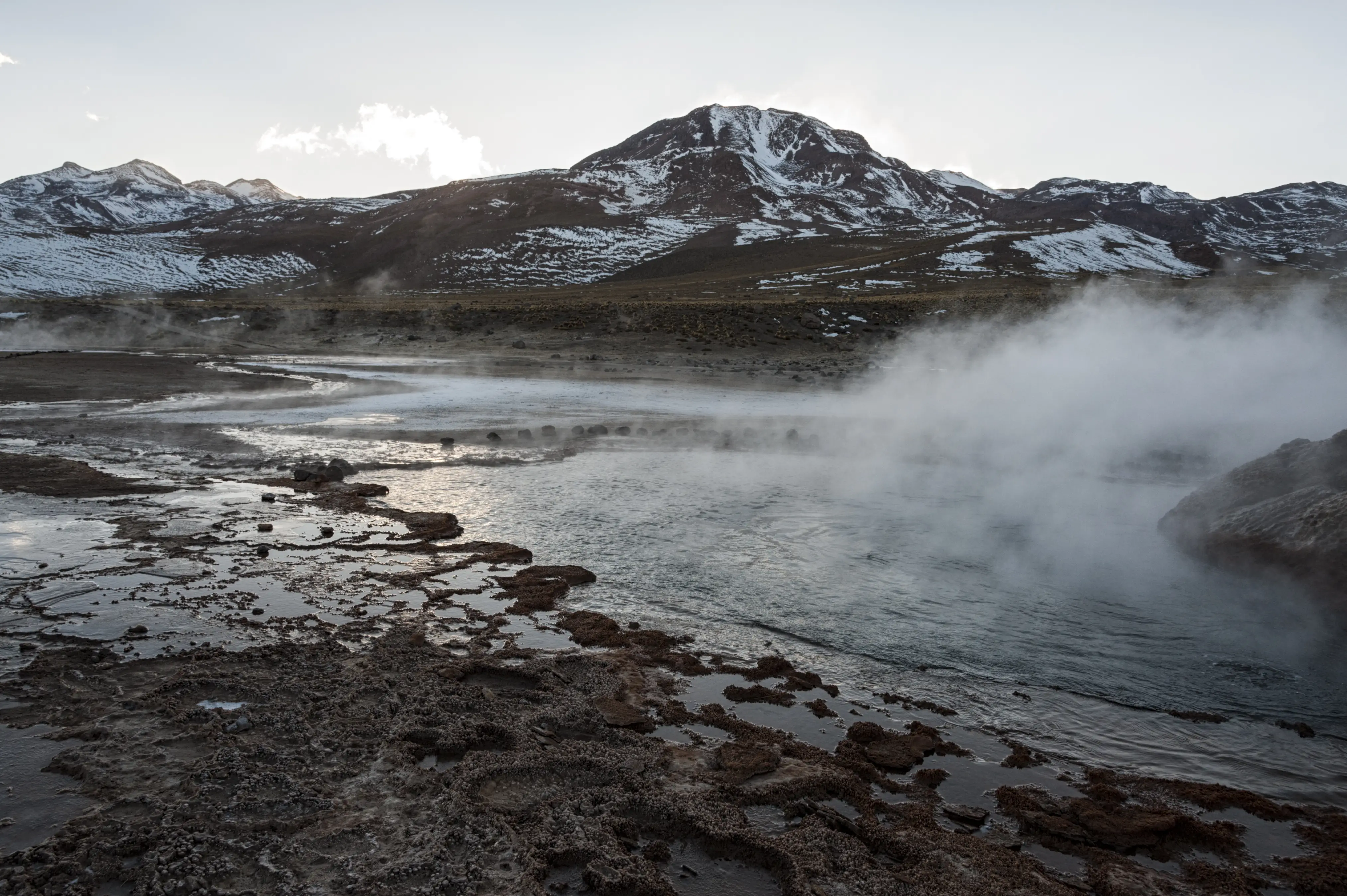
After Promising Net Zero Commitments, How to Expedite Geothermal Advancement?
The Central Geological Survey, MOEA, unveiled groundbreaking findings at the "2023 Taiwan International Geothermal Conference." After extensive exploration and analysis of geological and geophysical data using the Stored-Heat Volumetric Method, Taiwan's geothermal potential has been determined to be a staggering 40GW. Only Changhua and Yunlin counties lack geothermal resources (Figure 1). Remarkably, this figure surpasses Taiwan's peak electricity demand and does not even account for the geothermal potential from offshore underwater volcanoes (indicated by the red triangles in Figure 1).
Taiwan's northern coast is historically dominated by conventional power plants, but its surrounding boasts a staggering geothermal potential of up to 8.5 GW, stretching from Beitou to Jinshan and Wanli. Notably, this area lies close to an active underwater volcano, endowing it with a wealth of geothermal energy resources capable of compensating for the power deficits following the decommissioning of the Chin-shan Nuclear Power Plant, Kuosheng Nuclear Power Plant, and Taiwan Power Company Hsiehho Thermal Power Plant. Power Plant. Despite this promising outlook, Taiwan's limited experience in geothermal energy development has yet to find a place in TaiPower Company's power development plans.
According to the "Taiwan Net Zero Technology Development Policy Recommendations" presented by the National Academy Taiwan at the end of November 2022, geothermal energy technology is currently highly mature. In neighboring countries along the Pacific Ring of Fire, such as Indonesia and the Philippines, have multiple installations with a total capacity exceeding 1 GW.
These regions, characterized by volcanic and seismic threats, harbor geothermal energy derived from volcanoes and thermal manifestations like hot springs formed through fissures created by earthquakes. National Academy Taiwan provides specific recommendations. Starting from 2025, it suggests the annual development of conventional geothermal power generation ranging from 25 to 35 MW. Moreover, they recommend the adoption of advanced geothermal generation technologies from 2035 onward, with annual development targets of 500 to 800 MW. By 2050, Taiwan could potentially reach a geothermal power generation capacity between 8.13 to 12.88 GW, exceeding the national target of 3 GW to 6.2 GW for "The Net Zero Emissions by 2050."
If Taiwan's geothermal energy industry swiftly aligns with international advancements, geothermal energy may become the sole option to replace fossil-based electricity generation. Therefore, the Ministry of Economic Affairs (MOEA) has announced that 2023 will be a crucial moment for Taiwan in accelerating geothermal power generation.

Figure 1: Taiwan's Geothermal Resource Distribution and Geothermal Area Boundaries (Data Source: Bureau of Energy, Ministry of Economic Affairs).
The Cost and Value of Geothermal Energy
|Long-Term Negative Net Costs
In the book "Drawdown: The Most Comprehensive Plan Ever Proposed to Reverse Global Warming," tapping into geothermal energy emerges as a critical strategy. If the global share of geothermal power generation were to increase from its current 0.66% to 4.9% by 2050, it could reduce 16.6 billion tons of carbon dioxide emissions. Geothermal power generation demands no fuel, resulting in savings of a colossal $1.02 trillion US dollars in electricity costs over the long term. Furthermore, developing geothermal power plants necessitates investments in ancillary infrastructure such as roads, water sources, and power feeder lines, which can translate into government savings of nearly $2.1 trillion.
While establishing geothermal power plants requires a significant initial investment, the cost of geothermal energy remains relatively stable and cost-effective compared to other renewable energy sources. Presently, it ranks just slightly higher in cost than solar, hydro, and onshore wind energy but is comparable to biomass and offshore wind energy, approaching the lower end of the cost range for fossil fuel-based electricity generation (Figure 2).
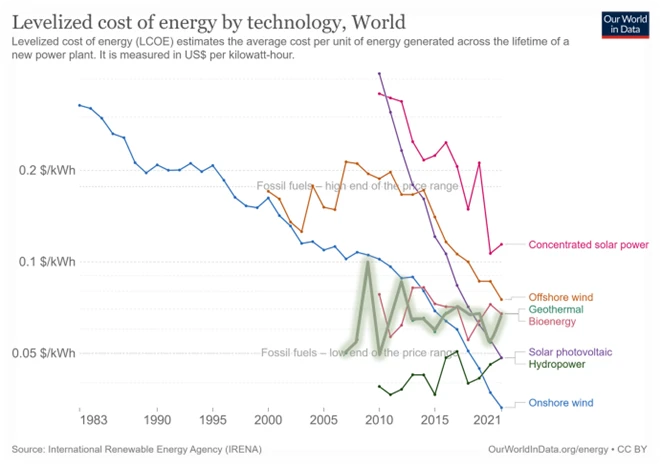
Figure 2: Average Cost Variations for Various Renewable Energy Sources, with fossil fuel costs ranging from $0.05 to $0.17 per kWh. The green line represents the cost curve for geothermal power generation, with a distribution range of $0.05 to $0.1 per kWh (Data source: Our World Data).
|Moving Beyond the Conventional to Achieve Excellence
Geothermal Power Generation encompasses the Conventional Geothermal System (CGS), which has been operational for over a century. CGS primarily harnesses natural steam and hot water as its working fluids.
This process induces thermal convection within subsurface reservoirs through geothermal wells. The extracted heat can be used to drive turbine generators using Flash Steam Generation or heat exchange with organic solvents of lower boiling points in Binary Geothermal Power Plants (B-GPP). This approach is often referred to as "Hydrothermal Geothermal," boasting an impressively low Levelized Cost of Electricity (LCOE) at just 2.1 Taiwanese New Dollars (0.07 USD/kWh). The global capacity for this form of geothermal power generation has already reached 16.1 GW (Figure 3).
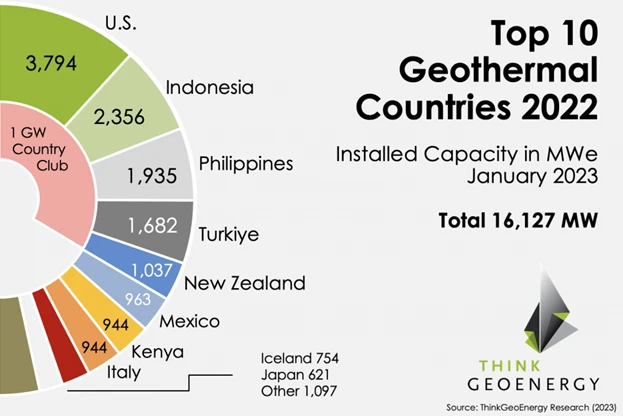
Figure 3: Ranking of the World's Top Ten Geothermal Power-Generating Nations and Their Cumulative Geothermal Power Production (Source: Think Geo Energy, 2023)
Geothermal energy cements Its position as America's most economical and reliable source of electricity, primarily due to its fuel-free and non-polluting characteristics. Nevertheless, despite the United States being the global leader in geothermal power generation, it continues actively subsidizing private enterprises to pursue more advanced heat extraction technologies (Figure 4). This strategic effort aims to make geothermal energy development more widespread and cost-effective, for instance, by creating artificial reservoirs that expand geothermal development beyond fault-fracture zones.
This significantly broadens the potential areas for geothermal exploitation, including Enhanced Geothermal Systems (EGS) and Advanced Geothermal Systems (AGS). Furthermore, high-efficiency drilling techniques enable the extraction of Superhot Rock from depths of 4-10 kilometers in Supercritical Geothermal Systems (SGS), leading to a tenfold increase in power generation capacity per well.
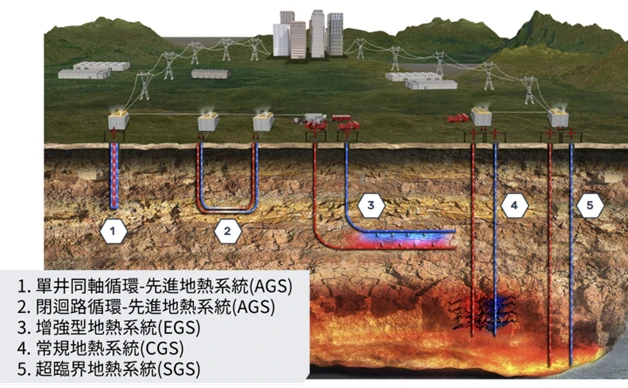
Figure 4: Halliburton classifies 5 different types of geothermal heat extraction technologies, with the 4th item being commercially available, while the rest are in various stages of development or validation. (Source: Halliburton Geothermal Services Brochure)
In 2023, three geothermal-related organizations in the United States anticipate the commercial viability of the three new technologies above by 2030, estimating the cost parameters of these innovative geothermal technologies. The Enhanced Geothermal Systems (EGS) are projected to cost around 1.35 New Taiwan Dollars per kWh (National Renewable Energy Laboratory, NREL 2023), the Advanced Geothermal Systems (AGS) are expected to cost approximately 0.9 New Taiwan Dollars per kWh (Mitchell Foundation 2023), and the Supercritical Geothermal Systems (SGS) are estimated to range between 0.6 and 0.7 New Taiwan Dollars per kWh (Hotrock Energy Research Organization, HERO 2023).
In 2023, the Geothermal Technologies Office (GTO) introduced the Enhanced Geothermal Shot™, building upon the analysis conducted in GeoVision 2019. The findings suggest that the scale of geothermal development in the United States could potentially reach 90 GW, surpassing the initial assessment of 60 gigawatts made in GeoVision 2019.
Taiwan relies heavily on imports for 98% of its energy, leaving it highly susceptible to fluctuations in international energy prices. For instance, the global surge in fossil fuel prices resulting from the Russia-Ukraine conflict pushed Taipower's average electricity generation cost to 3.89 New Taiwan Dollars per kWh in 2022 (based on Taipower's official data).
Considering carbon emissions, Taipower's electricity in 2022 had a carbon intensity of 509 grams of CO2 per kWh (according to the Bureau of Energy, Ministry of Economic Affairs website for 2022), whereas conventional geothermal power emitted just 38 grams. These parameters indicate that geothermal energy technology is the most practical option for achieving "zero carbon energy," placing it considerably closer to "The Holy Grail of Energy" than advanced nuclear power.
The Unique Advantages of Geothermal Power Generation
|Excellent Stability
Geothermal power generation stands alongside hydropower as one of the only two sources capable of delivering a consistent electricity supply in renewable energy. Its 24-hour continuous energy generation capability is comparable to base-load power sources such as fossil fuels and nuclear energy.
Currently, fossil fuel-based power generation, which has high carbon emissions, still accounts for over 50% of Taiwan's total electricity generation. These are challenges that "Taiwan's 2050 Net Zero Emissions Pathway" must address through innovative energy technologies. Geothermal energy is the sol base-load power source within this innovative energy spectrum. The stability of energy technologies can be assessed by examining their capacity factor, which measures the efficiency of energy production facilities. Well-designed geothermal power plants typically achieve a capacity factor of over 90%, making them 4.5 to 6 times more efficient than solar power (which typically ranges from about 15% to 20%). This indicates a 100MW geothermal power facility can produce as much electricity as a 450-600MW solar power facility.
|Efficient Land Use
Concerning another advantage of geothermal energy suitable for Taiwan's geographical characteristics: Geothermal power plants offer exceptional land use efficiency. Currently, conventional geothermal power generation can accommodate nearly 20MW of generating capacity per hectare, which is 20 times that of ground-mounted PV systems.
When comparing the benefits of one hectare of land for solar photovoltaic and geothermal power generation, the annual geothermal total generation can reach 90-120 times that of solar photovoltaic. Moreover, considering that geothermal power plants in countries such as Italy, Japan, the United States, and New Zealand have been in operation for over 60 years, it demonstrates that the lifecycle of geothermal power plants can surpass that of solar photovoltaic by more than threefold, making it the longest-lasting lifecycle among commercial power generation technologies.
|Environmentally Friendly
According to the UN Environment Programme (UNEP) report on "Green Energy Choices (UNEP, 2017)", geothermal power generation emerges as the energy technology with the least external impact on the environment, ecology, health, and landscape among the existing commercial energy options. Identifying the right combination of green energy technologies is crucial in minimizing the long-term effects of global pollution on the next generation. Given its highly environmentally friendly nature, geothermal energy has been one of New Zealand's self-developed green power sources since 1970. New Zealand has actively supported Taiwan's geothermal energy industry in recent years by sharing advanced technologies such as geothermal system assessments, simulations, and high-temperature drilling techniques.
|Community-Friendly
Geothermal power plants offer a community-friendly approach, enabling active participation in the industry. This is because the hot water generated after electricity production can be used in various industry cycles such as thermal tourism, agricultural symbiosis, and more (Figure 5). These applications encompass agricultural product drying, pasteurization of honey and milk, and aquaculture for fish and shrimp. Furthermore, the New Zealand government's support through Māori Trusts facilitates tribal investments in geothermal power plants, promoting Māori participation in geothermal plant development and utilization. This has become a key driver in New Zealand's short-term push for renewable energy.
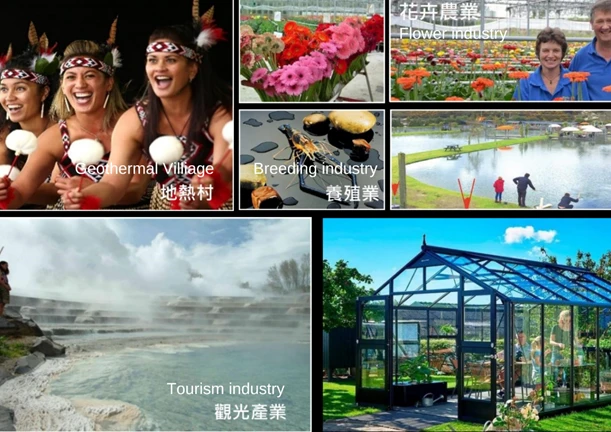
Figure 5: Illustrative Instances of Geothermal Energy Application in New Zealand's Tourism and Agriculture Sectors
|Short Development Timelines and Small Capital Requirements.
Geothermal power development boasts a shorter timeline than the large period for large power plants such as hydroelectric and nuclear, which often spans 7 to 10 years. With proper planning, results can be seen in as little as 1 to 3 years, as demonstrated by recent geothermal power nations like Hungary, Chile, and Croatia. Moreover, due to the maturity of international geothermal engineering technology, facilitating domestic industry and international collaboration becomes more accessible, bridging the current gap in advanced technology and experience.
Once the drilling phase is completed, the construction of geothermal power plants benefits from a relatively mature domestic industry chain. Regarding financial investment in the industry chain, offshore wind or gas power generation requires substantial infrastructure investments such as ports and specialized work vessels. In contrast, the geothermal industry chain, encompassing exploration, drilling, reservoir management, and power generation, has a relatively smaller scale, reducing the threshold for large-scale funding requirements.
Crucial Factors in Attracting Large-Scale Investments
|Real-time Earthquake Monitoring
Over the past decade, Sweden and South Korea have experienced two noteworthy cases of induced seismicity during drilling and injection processes. These incidents resulted in the termination of geothermal development projects. Catastrophic-induced earthquakes have occurred in regions with historically low seismic activity, typically when the injection pressures from hydro-fracturing or fluid reinjection exceed the strength of the surrounding rocks. Recently, seismologists have employed Seismic Downhole Arrays for real-time locating and measuring of micro-earthquakes generated during injection processes. They have established a Traffic Light System to prevent injection pressures from surpassing predetermined thresholds. This innovative approach has yielded promising results in geothermal well projects in Helsinki and the Netherlands.
|Open Data Mining
Taiwan began geothermal exploration in 1966, and relevant data was only available to the public on the Central Geological Survey's Geothermal Exploration Information Platform (https://geotex.geologycloud.tw/) starting in 2019. For corporate investments, government-opened data mining can significantly reduce the initial challenges of geothermal exploration. Currently, two privately owned geothermal power plants operating in tandem (Cingshuei Geothermal Power Plant and CY GeoEnergy) have benefited from ample geothermal exploration data before development. Similarly, the Taipower's Renze geothermal power station, Chinese Petroleum Corporation (CPC) Tuchang Geothermal Area, and FABULOUS POWER's Shi-Hung-Ping Geothermal Power Plant, set for commercial operation in 2023, are also being redeveloped based on exploration data from 40 years ago.
|Civic Communication and Collaborating with Communities
Based on existing geothermal exploration data, 90% of Taiwan's geothermal regions are located within indigenous traditional territories, such as the Zhiben (Jhihben) Hot Springs Region, Wulai Hot Springs Region, and Qingshui Geothermal Region. However, The Indigenous Peoples Basic Law does not provide substantial guidance on Indigenous tribal involvement in geothermal development. If the government could draw valuable lessons from New Zealand's experience and proactively engage in tribal and community negotiations and cooperative discussions, it would greatly enhance the efficiency of industrial development.
|Advancing Exploration Techniques
Various geothermal exploration methods come with distinct limitations and blind spots, necessitating a fusion of their unique characteristics to evaluate resource conditions. With limited domestic experience in geothermal resource exploration, international collaboration is required to introduce advanced exploration technologies and swiftly overcome the initial learning curve. Currently, techniques such as aeromagnetic prospecting, High-resolution microseismic array, and high-resolution Magnetotelluric (MT) have been applied domestically. However, as geothermal development is still in its infancy within the country, misconceptions about geothermal systems and exploration data can lead to erroneous drilling plans and site selection, resulting in substantial budget and schedule overruns. For instance, this issue was encountered in Taiwan's Green Island geothermal power project and the Ministry of Science and Technology's Geothermal Energy Main Program. Typically, drilling costs range from tens of millions to billions of dollars. In contrast, the costs of other geophysical, geochemical, and geological surveys range from several million to tens of millions, offering 2D to 3D spatial information. Proficiency in exploration experience can eliminate the need for drilling in certain areas, reducing the risk of errors.
Conclusions
After years of advocacy from the academic and industrial sectors in Taiwan, the government has formulated a more defined strategy for advancing geothermal energy. For instance, they have publicly disclosed the outcomes of past government investments in geothermal exploration. Furthermore, in the recent revision of the "Renewable Energy Development Act," a dedicated "Chapter for Geothermal Energy" has been incorporated. These steps aim to resolve administrative hurdles local governments face in reviewing geothermal power plants under the "Hot Spring Act," introduce more favorable exploration incentives, prioritize community engagement, and implement mechanisms for indigenous consultation.
However, despite these positive steps, Taiwan has not kept pace with the rapid advancements in international cutting-edge geothermal technologies through international cooperation. Additionally, there is a lack of a clear path for geothermal development in the forward-looking energy policy of achieving net-zero emissions. The upcoming National Spatial Planning also needs early consideration of land-use regulations for geothermal energy development applications. These measures hold the potential to scale up geothermal energy, crucially transforming Taiwan's abundant geothermal resources into sustainable energy sources. Achieving this goal still requires diligent efforts from our generation, driven by individuals who are passionate about this cause.
Reference:
1. 臺灣淨零科技研發政策建議書|中央研究院 (2022)
https://sec.sinica.edu.tw/pages/1552
2. 臺灣2050淨零排放路徑及策略總說明|國家發展委員會 (2022)
https://www.ndc.gov.tw/Content_List.aspx?n=DEE68AAD8B38BD76
3. Drawdown 反轉地球暖化100招|聯經出版社 (2019)
4. Green Energy Choices: The Benefits, Risks and Trade-offs of Low-carbon Technologies for Electricity Production|UNEP, 2017:
https://www.unep.org/resources/report/green-energy-choices-benefits-risks-and-trade-offs-low-carbon-technologies
5. Halliburton Geothermal Services Brochure|Halliburton, 2022:
https://www.halliburton.com/en/resources/geothermal-services-brochure
6. SUPERHOT ROCK GEOTHERMAL: Technology Needs for Scaling
Geothermal Resources Globally|Hotrock Energy Research Organization, 2023:
https://www.hotrockhero.org/
7. The Future of Geothermal in Texas: THE COMING CENTURY OF GROWTH & PROSPERITY IN THE LONE STAR STATE|Mitchell Foundation, 2023:
8. Enhanced Geothermal Shot Analysis for the Geothermal Technologies Office|National Renewable Energy Laboratory, 2023:

Shou-Cheng Wang
Shou-Cheng Wang serves as a geothermal scientist at the National Taiwan Ocean University. Before his doctoral studies, Wang garnered over 5 years of experience as a senior geologist in both a geothermal engineering company and a consulting firm. Joining the Geothermal team at NTOU, he has made significant contributions to the realms of geothermal science, education, and policymaking. Since 2018, he has collaborated with experts from Lawrence Berkeley National Laboratory (LBNL) on high-resolution micro-seismic exploration projects.
With a longstanding focus on energy transformation, Wang has actively engaged with various environmental organizations. Commencing in 2017, Wang has been fervently involved in raising awareness about geothermal energy, continually updating the global developments through social media platforms in Taiwan. In 2019, he spearheaded the establishment of the "Taiwan Geothermal Association", fostering stronger connections with international groups and advocating for more favorable legal frameworks in geothermal energy in collaboration with dedicated industry players and academic experts.
More related articles
